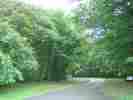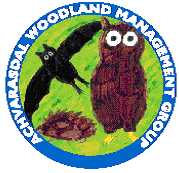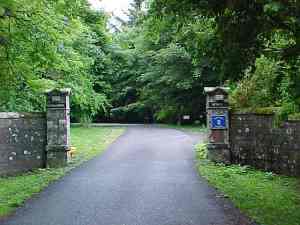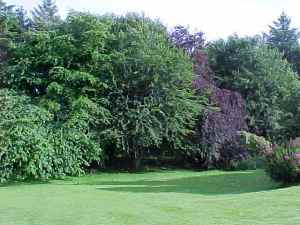|
COMING EVENTS.
Thursday, 25th November at 7.30 p.m.: AGM of AWMG.
Meet in the Committee Room of Reay village hall. The business of the
meeting should not take very long, but it is an opportunity for anybody to
raise any issues about the management of the woodlands. Afterwards there
will be a quiz. All will be divided into teams, dependant on numbers, who
will then compete to answer puzzles based on general knowledge of the
Achvarasdal locality.
Friday, 26th November:
Adventure night time experience for young children.
This is a reminder of a Highland Council Ranger event to be held in the
woods. Ring the North Caithness Ranger on 01847 821531 for further
details, or look out for posters nearer to the time.
Achvarasdal Woodland Walk
 50
Photos 50
Photos
Past Activities and Events

|
ACHVARASDAL - AN
OLD WOODLAND UNDER NEW MANAGEMENT
This small enclosure of nearly 13 Hectares, is the most accessible
naturalised woodland in this area. It appears to be hardly known by those
speeding by on the busy but unclassified road from Thurso to Reay. Yet it
stands out as the only mixed trees in the area: about one kilometre from
the junction with the A836 on the outskirts of Reay. It is tested by salt
laden winds from the north west and fierce gales from the south east, yet
within is another world. Its secret lies in the ages it has been protected
from fire and grazing stock. The first Ordnance Survey of 1874 showed
avenues and an established wood. A recent tree survey shows evidence of
careful planting and later natural regeneration. For most of the last
fifty years little has been done beyond maintaining the boundaries.
Examples can be found of all stages of death, decay, re-growth and
seedlings of many ages and species. It is a sanctuary for an impressive
variety of wildlife.
Formation of the
Achvarasdal Woodlands Management Committee
 The land and house was gifted to the Church of Scotland in 1949 as a home
for the old folk. Before that it was used as a hunting lodge. The Highland
Regional Council became involved with helping the Kirk manage the property
in return for public access in the 1980s. They opened some paths, planted
some trees after the severe gale in 1989 and cleared some areas of old
commercial forest. The outstanding success of the work was the
establishment of some Sessile Oaks which are thriving. The arrangement was
formalised by granting a lease to the local authority, which would also
involve local people in a management group. The succeeding Highland
Councilís relative poverty prevented it, until recently, doing any further
work. The land and house was gifted to the Church of Scotland in 1949 as a home
for the old folk. Before that it was used as a hunting lodge. The Highland
Regional Council became involved with helping the Kirk manage the property
in return for public access in the 1980s. They opened some paths, planted
some trees after the severe gale in 1989 and cleared some areas of old
commercial forest. The outstanding success of the work was the
establishment of some Sessile Oaks which are thriving. The arrangement was
formalised by granting a lease to the local authority, which would also
involve local people in a management group. The succeeding Highland
Councilís relative poverty prevented it, until recently, doing any further
work.
The Achvarasdal Woodland
Management Group was formed in 1999 from the local community. It part
elects annually a committee to act in an advisory capacity and as a fund
raiser for land leased by the Church of Scotland to the Highland Council
for public access. The rest of the committee is made up from Church
representatives, with Highland and Community Councillors. It is also a
recognised charity. The committee was thrown into the deep end to raise
funds, then manage contractors for road surfacing and path building.
Voluntary work so far has mainly involved weeding out the over generous
bounty of Sitka Spruce and other alien seedlings as well as an annual task
of clearing growth around the Broch and along the paths.
Aims Of The Committee
With so many different interests, it would not be easy to formulate a long
term management plan. We have started formulating a management guide,
based on agreed principles. In the short term we are concerned with new
interpretative signs, stopping the wood encroaching on the Broch area,
dealing with dangerous trees and tidying up the paths.
Advice from SNH and NHFT
together with indications from the past have convinced most of us that
there is no call for large scale replanting schemes. We will be content if
we can gradually improve the mix of ages and species: with more emphasis
on native trees. We would also like to encourage its educational use.
We have made a start at describing its wildlife, dependant on the Ranger
Service and local amateur enthusiasts. Not surprisingly this is best on
ornithology, but sadly lacking on entomology. Our main hope is that we can
encourage local schools and colleges to set up wildlife studies.
The Woodland Trail and
Features.
Walks
Except for extreme weather conditions, the paths are made for easy walking
(or running) in light shoes. Combining the 2 Km. of paths and drives,
provides a variety of scenery and walking times. The Highland Council and
Highland Access Project have plans for a new welcome signs, interpretation
panel and waymarkers. On the site of a recently demolished bungalow, we
intend to make a meeting area with a bench and a board for current
information.
Woods
 This is an old naturalised woodland, with a count of 35 tree species of
which 19 are native to Britain. It was shown on the first Ordnance Survey
map of 1874, just after Achvarasdal House was built as a shooting lodge,
for Sir Robert Sinclair of Murkle. Since the Church of Scotland received
the property in 1949, there have been few attempts at new plantations. The
trees have mainly regenerated in the natural way by seeds and re-growth of
wind-falls, and fertilised by the cycles of death and decay. It is home
for a diversity of wildlife, which depends on the trees and in many cases
helps to sustain them. There are a variety of areas of differing tree
types and ages, with different soils. Each has its complementary
under-storey of flowers, grasses, ferns, mosses, liverworts, lichens and
fungi. These have their peculiar adherents of insects and invertebrates;
in their turn providing snacks for diverse roosting and nesting birds and
other animals. This is an old naturalised woodland, with a count of 35 tree species of
which 19 are native to Britain. It was shown on the first Ordnance Survey
map of 1874, just after Achvarasdal House was built as a shooting lodge,
for Sir Robert Sinclair of Murkle. Since the Church of Scotland received
the property in 1949, there have been few attempts at new plantations. The
trees have mainly regenerated in the natural way by seeds and re-growth of
wind-falls, and fertilised by the cycles of death and decay. It is home
for a diversity of wildlife, which depends on the trees and in many cases
helps to sustain them. There are a variety of areas of differing tree
types and ages, with different soils. Each has its complementary
under-storey of flowers, grasses, ferns, mosses, liverworts, lichens and
fungi. These have their peculiar adherents of insects and invertebrates;
in their turn providing snacks for diverse roosting and nesting birds and
other animals.
Ancient Monuments
There is a Broch, with nearby two curious prostrate stones surviving from
pre-historic times. Both would merit attention from keen archaeologists to
explain puzzling features. Little evidence remains of more recent human
activities, apart from the well crafted estate walls and buildings. An
attempt at iron ore mining was made to the east of the policies in the
early 1870s. A nearby windmill, shown on the 1874 map, was perhaps
intended for pumping.
Contacts.
Chairman: Mrs Andrea Smith; Tel. 01847892590
Secretary: Tony Bradford; 01847811298
Members: Mrs Alison Cook; Mrs Carol Simpson (Church of Scotland)
Cllr Alexander Mackay (Highland Council)
Cllr George McDougall (Community Council)
Geoff Bates; Mrs Irene Hamilton; Iain Hamilton; Eric Maughan; Rod Foster
All the elected members
are liable to change on an annual basis. The West Caithness Ranger Service
(tel. 01847 821531) would accept any wildlife or historical records (and
pass them on); or answer enquiries. |



